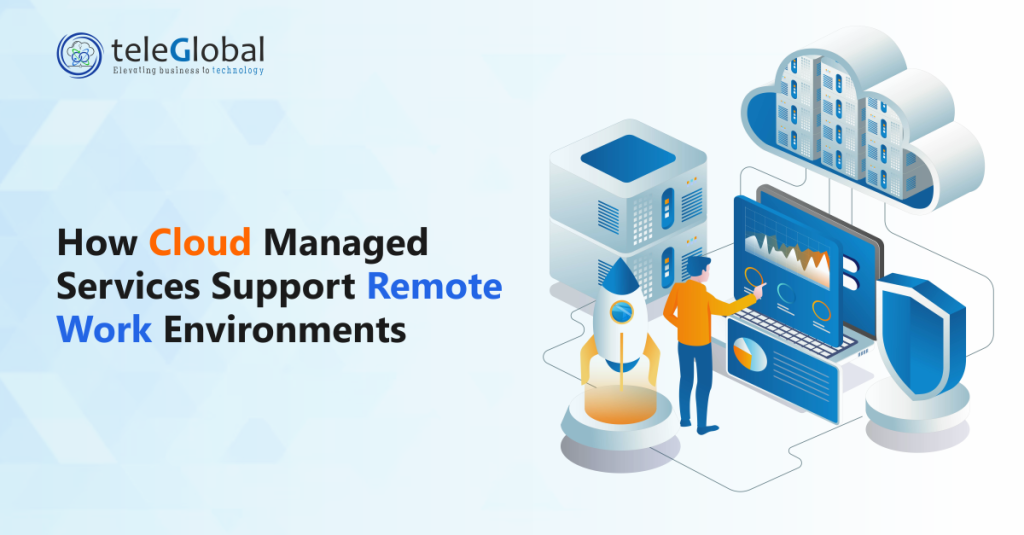
| Author: Ashish Kumar | Published: 27-Jan-2024 |
Remote work is no longer just a temporary shift. It has become a permanent part of how many businesses operate. As fully remote and hybrid teams become the norm, having a reliable and well-structured IT foundation is now essential for smooth operations. That’s where Cloud Managed Services come in. They offer reliable support for people working from home, help control cloud spend, and ensure productivity stays high.
Whether your team is collaborating from multiple cities or contractors are working from home, cloud managed services deliver peace of mind. They handle infrastructure, security, backups, scaling, monitoring, and more. Let’s explore how they enable remote work, support work from home systems and deliver business value through cost optimization, microservices and blockchain integration, and other approaches.
Remote environments can be fragile if infrastructure isn’t carefully managed. Teams depend on performance, access, and security across different time zones. Here’s what cloud managed services offer:
Workforces often span different geographies and apps may run on multiple clouds. A multicloud management platform gives consistent visibility and control. Managed Kubernetes (like Amazon EKS) ensures containers are deployed uniformly and scale effortlessly for remote users.
Access needs to be managed carefully. With remote teams, entitlement tools make sure permission is assigned, revoked automatically when roles change, and every action is logged, delivering secure remote access.
Remote data is often at risk lost files, accidental deletions, and divergence. A managed backup service ensures user data, project work, and configurations are saved regularly and can be restored swiftly when needed.
The cloud managed services market is on the rise, reflecting demand from businesses supporting remote teams. In 2024, it was valued near USD $150 billion and is expected to grow consistently in the coming years. That growth is fuelled by companies that choose outsourcing to manage cloud infrastructure, enforce security, and reduce internal IT workload, especially for remote setups.
Imagine a mid-sized company where 40% of staff are working from home. IT needs to support collaboration tools, internal apps, access to shared databases, and more. Without managed services, setting up, scaling, securing, and maintaining this infrastructure becomes a burden.
Let’s illustrate with a realistic scenario: A company supports developers, customer support reps, and virtual assistants working from home. They rely on Jenkins pipelines, containerized apps running in managed Kubernetes, and document storage backed up daily.
Enable managed backup services so remote teams never lose work and meet compliance requirements.
Supporting a remote workforce requires more than exposing internal apps. It takes infrastructure that stays available, secure, cost‑efficient, and scalable. That is exactly what Cloud Managed Services deliver. From enabling work from home setups and virtual assistant jobs remote roles to deploying containerized workloads via managed Kubernetes, these services power modern teams.
We at Teleglobal partner with businesses to deliver full-stack support from infrastructure architecture and cloud infrastructure entitlement management to cloud cost management, managed backups, and monitoring.
These are services where a provider manages your cloud infrastructure-handling monitoring, maintenance, patching, cost control, backup, and security for you.
Services such as managed Kubernetes, entitlement controls, backups, and cost monitoring allow teams to work securely and efficiently from home.
Yes. Remote work can spike usage, and managed services deliver cloud cost management and AWS cost management tools to control spend.
Yes. Microservices and blockchain integration enable decentralized, secure transaction models. Managed services ensure SLAs, access control, and cost efficiency.
 close
close

Hi there! At TeleGlobal, we turn your cloud vision into AI-accelerated reality. What challenge can we help you solve?
Powered by ![]() teleBot
teleBot